Consolidating the Role of AI in the Economy and Society: Combating the Deepfake Phenomenon Through Strategic and Normative Approaches—The Case of Romania in the EU Context
Abstract
1. Introduction
2. AI—Concept and Importance for the Economy and Society
3. Institutional Concerns in the EU Regarding AI Issues
3.1. Guidelines and Steps Taken Towards Maximizing the Opportunities Offered by AI
3.2. Strategic and Normative Benchmarks for Implementing AI in the EU
3.2.1. Some Features of the AI Strategic Framework in the EU
3.2.2. Developments Following the Launch of the Strategic AI Framework in the EU
- Increasing productivity by creating a virtual workforce;
- Automating complex processes that can solve problems and improve autonomously;
- Driving innovation, which generates new economic sectors and sources of revenue.
3.2.3. Development and Adoption of the EU AI Act
3.2.4. AI Pact
4. Preparations of a Strategic and Normative Nature at the Level of the Romanian State for AI Era
4.1. Romania’s Adoption of the NAIS
- Progress in research and innovation in ICT: this will include the development of human resources, increased expertise, and recognition both nationally and internationally.
- Improvement of AI education and training: the strategy will support the development and preparation of AI specialists through the educational system, ensuring a solid skill base in the field.
- Dissemination of AI knowledge and skills: it will promote the spread of these among the population and the business sector, facilitating the integration of AI across various domains.
- Development of AI infrastructure: investments will be made in specific infrastructures, regulations, and datasets, which are important for technological advancement.
- Strengthening the institutional AI ecosystem: the strategy will promote the development of research centers, specialized companies, and spaces for testing and experimenting with AI solutions.
4.2. Enhancing/Improving the National Regulatory Framework
4.2.1. Drafting an AI Law—The Coordinates for Regulation, Implementation, Use, Development, and Protection of AI in Various Environments
4.2.2. Legislative Attempts to Prevent the Deepfake Phenomenon
The Need for Responsible Use of Technology in the Context of the Deepfake Phenomenon
The Prefiguration of a Special Norm
5. Conclusions
Future Research Directions
Funding
Data Availability Statement
Acknowledgments
Conflicts of Interest
Abbreviations
| ADR | Authority for Digitalization of Romania (ADR) |
| AI | Artificial intelligence |
| AI HLEG | High-Level Expert Group on Artificial Intelligence |
| ALTAI | Assessment list on trustworthy AI |
| EC | European Commission |
| ECA | European Court of Accounts |
| EP | European Parliament |
| EU | European Union |
| GANs | Generative adversarial networks |
| GO | General objective |
| GPAI | General-purpose AI models |
| ICT | Information and communication technology |
| MCID | Ministry of Digitalization |
| NAIS | National AI Strategy |
| NCD | National Cybersecurity Directorate |
| OECD | Organisation for Economic Co-operation and Development |
| RDI | Research, development, and innovation |
| RG | Romanian Government |
| RP | Romanian Parliament |
| SMEs | Small- and medium-sized enterprises |
| SO | Specific objective |
| TEF | Testing and Experimentation Facility |
References
- Abhivardhan. (2024). Artificial intelligence ethics and international law (2nd ed.). Practical Approaches to AI Governance. BPB Publications. [Google Scholar]
- Ajami, R. A., & Karimi, H. A. (2023). Artificial intelligence: Opportunities and challenges. Journal of Asia-Pacific Business, 24(2), 73–75. [Google Scholar] [CrossRef]
- Attias, D. (2017). The autonomous car, a disruptive business model? In D. Attias (Ed.), The automobile revolution: Towards a new electro-mobility paradigm. Springer International Publishing. [Google Scholar] [CrossRef]
- Avătămăniței, S., Beguni, C., Căilean, A., Dimian, M., & Popa, V. (2021). Evaluation of misalignment effect in vehicle-to-vehicle visible light communications: Experimental demonstration of a 75 meters link. Sensors, 21, 3577. [Google Scholar] [CrossRef] [PubMed]
- Banu, M. (2022). Reglementarea sistemelor de inteligență artificială la nivelul Uniunii Europene. Departamentul de Studii Parlamentare și Politici UE. Direcția Pentru Uniunea Europeană. Romanian Parliament, Bucharest. Available online: https://www.cdep.ro/afaceri_europene/afeur/2022/st_3507.pdf (accessed on 7 November 2024).
- Bellman, R. (1985). Artificial intelligence: Can computers think? Boyd & Fraser Publishing Company. [Google Scholar]
- Bradu, R., & Cădariu, N. (2024). AI, deepfake și decredibilizarea unei probe până acum incontestabile. Juridice.ro. Available online: https://www.juridice.ro/731649/ai-deepfake-si-decredibilizarea-unei-probe-pana-acum-incontestabile.html (accessed on 24 December 2024).
- Burgess, M., & WIRED. (2021). Artificial intelligence. How machine learning will shape the next decade (WIRED guides). Cornerstone Digital. [Google Scholar]
- Chaubard, F. (2023). AI for retail. A practical guide to modernize your retail business with AI and automation. John Wiley & Sons Inc. [Google Scholar]
- Cimpoeru, D. (2013). Dreptul internetului. Publishing House C.H. Beck. [Google Scholar]
- Ciutacu, I. (2022). The effects of the implementation of artificial intelligence in justice on fundamental rights and procedural rights. UNBR—Working Paper WP. Available online: https://www.unbr.ro/wp-content/uploads/2022/06/4_Ciutacu-Ioana_Efectele-implementarii-inteligentei-artificiale-in-justitie.pdf (accessed on 9 November 2024).
- Coeckelbergh, M. (2020). AI ethics. MIT Press. [Google Scholar]
- Constantin, L. (2022). Ce este inteligența artificială? Cum funcționează, domenii de utilizare, riscuri și viitorul acesteia. Available online: https://techcafe.ro/stiinta/ce-este-inteligenta-artificiala-cum-functioneaza-domenii-de-utilizare-riscuri-si-viitorul-acesteia (accessed on 2 November 2024).
- Custers, B., & Villaronga, E. F. (2022). Law and artificial intelligence regulating AI and applying AI in legal practice (B. Custers, Ed.). Springer. Available online: https://link.springer.com/book/10.1007/978-94-6265-523-2 (accessed on 7 November 2024).
- Davenport, T., & Mittal, N. (2023). All-in on AI. How smart companies win big with artificial intelligence. Harvard Business Review Press. [Google Scholar]
- Dumitrescu, D. (1996). Inteligenta artificiala. Retele neuronale. Teorie si aplicatii. Teora. [Google Scholar]
- Duțu, M. (2024, April 5). Spre un drept al inteligenței artificiale. Premise, actualități. Perspective. Comunicare Susținută în Cadrul Conferinței Internaționale “Casa Ecologiei”, Bucharest, Romania. Available online: https://www.juridice.ro/essentials/7653/ce-fel-de-reglementare-ce-fel-de-etica-ce-drept-pentru-inteligenta-artificiala (accessed on 7 November 2024).
- EC/European Commission. (2015). A digital single market strategy for Europe. Communication from the Commission to the European parliament, the Council, the European economic and social committee and the Committee of the regions {SWD(2015) 100 final}. Available online: https://eur-lex.europa.eu/legal-content/EN/TXT/PDF/?uri=CELEX:52015DC0192 (accessed on 9 November 2024).
- EC/European Commission. (2018a). Artificial intelligence: Commission kicks off work on marrying cutting-edge technology and ethical standards. Available online: https://ec.europa.eu/commission/presscorner/detail/en/IP_18_1381 (accessed on 11 November 2024).
- EC/European Commission. (2018b). Artificial intelligence: Commission outlines a European approach to boost investment and set ethical guidelines. Available online: https://ec.europa.eu/commission/presscorner/detail/en/IP_18_3362 (accessed on 11 November 2024).
- EC/European Commission. (2018c, December 18). Artificial intelligence: Draft Ethics guidelines for trustworthy AI. Brussels. Available online: https://digital-strategy.ec.europa.eu/en/library/draft-ethics-guidelines-trustworthy-ai (accessed on 11 November 2024).
- EC/European Commission. (2018d). Commission appoints expert group on AI and launches the European AI alliance. Available online: https://digital-strategy.ec.europa.eu/en/node/2891/printable/pdf (accessed on 12 November 2024).
- EC/European Commission. (2018e). Communication from the Commission to the European parliament, the European council, the Council, the European economic and social committee and the Committee of the regions. Coordinated plan on artificial intelligence, COM(2018) 795 final. Available online: https://eur-lex.europa.eu/legal-content/RO/TXT/HTML/?uri=CELEX:52018DC0795&from=FR (accessed on 12 November 2024).
- EC/European Commission. (2018f). Communication from the Commission to the European parliament, the European council, the Council, the European economic and social committee and the Committee of the regions on artificial intelligence for europe. Policy and legislation. Available online: https://eur-lex.europa.eu/legal-content/EN/TXT/PDF/?uri=CELEX:52018DC0237 (accessed on 12 November 2024).
- EC/European Commission. (2018g). Coordinated plan on the development and use of artificial intelligence made in Europe—2018. ANNEX to the Communication from the Commission to the European parliament, the European council, the Council, the European economic and social committee and the Committee of the regions, COM(2018) 795 final. Available online: https://digital-strategy.ec.europa.eu/en/policies/european-approach-artificial-intelligence (accessed on 14 November 2024).
- EC/European Commission. (2018h). Liability for emerging digital technologies accompanying the document, Communication from the Commission to the European parliament, the European Council, the council, the European economic and social committee and the Committee of the regions. Commission staff working document: Artificial intelligence for Europe {COM(2018) 237 final}. Available online: https://digital-strategy.ec.europa.eu/en/library/european-commission-staff-working-document-liability-emerging-digital-technologies (accessed on 11 November 2024).
- EC/European Commission. (2018i). Member states and commission to work together to boost AI “made in Europe”. Available online: https://ec.europa.eu/commission/presscorner/detail/en/IP_18_6689 (accessed on 12 November 2024).
- EC/European Commission. (2018j). Stakeholder consultation on draft ethics guidelines for trustworthy AI. Available online: https://ec.europa.eu/futurium/en/ethics-guidelines-trustworthy-ai/stakeholder-consultation-guidelines-first-draft.html (accessed on 2 November 2024).
- EC/European Commission. (2018k). The European AI alliance. Available online: https://digital-strategy.ec.europa.eu/en/policies/european-ai-alliance (accessed on 2 November 2024).
- EC/European Commission. (2019a). Communication from the Commission to the European parliament, the European Council, the council, the European economic and social committee and the Committee of the regions. Building trust in human-centric artificial intelligence, COM(2019) 168 final. Available online: https://digital-strategy.ec.europa.eu/en/library/communication-building-trust-human-centric-artificial-intelligence (accessed on 17 November 2024).
- EC/European Commission. (2019b). Ethics guidelines for trustworthy AI. High-level expert group on artificial intelligence. Available online: https://digital-strategy.ec.europa.eu/en/library/ethics-guidelines-trustworthy-ai (accessed on 14 November 2024).
- EC/European Commission. (2019c). Pilot the assessment list of the ethics guidelines for trustworthy AI. Available online: https://ec.europa.eu/futurium/en/ethics-guidelines-trustworthy-ai/pilot-assessment-list-ethics-guidelines-trustworthy-ai.html (accessed on 17 November 2024).
- EC/European Commission. (2019d). Policy and investment recommendations for trustworthy AI. High-level expert group on artificial intelligence. Available online: https://digital-strategy.ec.europa.eu/en/library/policy-and-investment-recommendations-trustworthy-artificial-intelligence (accessed on 17 November 2024).
- EC/European Commission. (2019e). The first European AI alliance assembly. Available online: https://digital-strategy.ec.europa.eu/en/events/first-european-ai-alliance-assembly (accessed on 17 November 2024).
- EC/European Commission. (2020a). Artificial intelligence—ethical and legal requirements. Available online: https://ec.europa.eu/info/law/better-regulation/have-your-say/initiatives/12527-Artificial-intelligence-ethical-and-legal-requirements_en (accessed on 22 November 2024).
- EC/European Commission. (2020b). Assessment list for trustworthy AI (ALTAI). High-level expert group on artificial intelligence (AI HLEG) presented their final assessment list for trustworthy AI. Available online: https://digital-strategy.ec.europa.eu/en/library/assessment-list-trustworthy-artificial-intelligence-altai-self-assessment (accessed on 22 November 2024).
- EC/European Commission. (2020c). High-level expert group on AI: Sectorial recommendations of trustworthy AI. Available online: https://digital-strategy.ec.europa.eu/en/policies/expert-group-ai (accessed on 22 November 2024).
- EC/European Commission. (2020d). On artificial intelligence—A European approach to excellence and trust—COM(2020) 65 final. Available online: https://commission.europa.eu/document/download/d2ec4039-c5be-423a-81ef-b9e44e79825b_en?filename=commission-white-paper-artificial-intelligence-feb2020_en.pdf (accessed on 2 November 2024).
- EC/European Commission. (2020e). Second European AI alliance assembly. Available online: https://digital-strategy.ec.europa.eu/en/events/second-european-ai-alliance-assembly (accessed on 23 November 2024).
- EC/European Commission. (2020f). White paper on artificial intelligence—A European approach to excellence and trust. Available online: https://digital-strategy.ec.europa.eu/en/node/798/printable/pdf (accessed on 2 November 2024).
- EC/European Commission. (2021a). Communication on fostering a European approach to artificial intelligence. Available online: https://digital-strategy.ec.europa.eu/en/node/9758/printable/pdf (accessed on 25 November 2024).
- EC/European Commission. (2021b). Coordinated plan on artificial intelligence. Available online: https://digital-strategy.ec.europa.eu/en/library/coordinated-plan-artificial-intelligence-2021-review (accessed on 23 November 2024).
- EC/European Commission. (2021c). High-level conference on AI: From ambition to action. Available online: https://digital-strategy.ec.europa.eu/en/node/10210/printable/pdf (accessed on 29 November 2024).
- EC/European Commission. (2021d). Impact assessment of the regulation on artificial intelligence, policy and legislation. Available online: https://digital-strategy.ec.europa.eu/en/library/impact-assessment-regulation-artificial-intelligence (accessed on 23 November 2024).
- EC/European Commission. (2021e). Opinion factsheet European approach to artificial intelligence—AI act (opinion number: CDR 2682/2021)—The European committee of the regions CoR). Available online: https://eur-lex.europa.eu/legal-content/EN/TXT/PDF/?uri=CELEX:52021AR2682 (accessed on 2 December 2024).
- EC/European Commission. (2021f). Opinion of the European central bank of 29 December 2021 on a proposal for a regulation laying down harmonised rules on artificial intelligence (CON/2021/40) (2022/C 115/05), preparatory acts. Available online: https://eur-lex.europa.eu/legal-content/EN/TXT/PDF/?uri=CELEX:52021AB0040 (accessed on 2 November 2024).
- EC/European Commission. (2021g). Product liability directive—Adapting liability rules to the digital age, circular economy and global value chains. Available online: https://ec.europa.eu/info/law/better-regulation/have-your-say/initiatives/12979-Product-Liability-Directive-Adapting-liability-rules-to-the-digital-age-circular-economy-and-global-value-chains_en (accessed on 25 November 2024).
- EC/European Commission. (2021h). Proposal for a regulation laying down harmonised rules on artificial intelligence. Available online: https://digital-strategy.ec.europa.eu/en/node/9756/printable/pdf (accessed on 25 November 2024).
- EC/European Commission. (2021i). Proposal for a regulation of the European parliament and of the Council laying down harmonised rules on artificial intelligence (AI Act) and amending certain union legislative acts. Available online: https://data.consilium.europa.eu/doc/document/ST-14278-2021-INIT/en/pdf (accessed on 29 November 2024).
- EC/European Commission. (2021j). Proposal for a regulation of the European parliament and of the Council on general product safety, amending Regulation (EU) No. 1025/2012 of the European parliament and of the Council, and repealing Council Directive 87/357/EEC and directive 2001/95/EC of the European parliament and of the council, COM/2021/346 final. Available online: https://eur-lex.europa.eu/legal-content/EN/TXT/PDF/?uri=CELEX:52021PC0346 (accessed on 25 November 2024).
- EC/European Commission. (2021k). Regulation on artificial intelligence. Available online: https://www.eesc.europa.eu/en/our-work/opinions-information-reports/opinions/regulation-artificial-intelligence (accessed on 26 November 2024).
- EC/European Commission. (2022a). Artificial intelligence act: Council calls for promoting safe AI that respects fundamental rights. Available online: https://www.consilium.europa.eu/en/press/press-releases/2022/12/06/artificial-intelligence-act-council-calls-for-promoting-safe-ai-that-respects-fundamental-rights (accessed on 4 December 2024).
- EC/European Commission. (2022b). EC. Launch event for the Spanish regulatory sandbox on artificial intelligence. Available online: https://digital-strategy.ec.europa.eu/en/node/11008/printable/pdf (accessed on 2 December 2024).
- EC/European Commission. (2022c). Liability rules for artificial intelligence. Available online: https://commission.europa.eu/business-economy-euro/doing-business-eu/contract-rules/digital-contracts/liability-rules-artificial-intelligence_en (accessed on 3 December 2024).
- EC/European Commission. (2023a). Commission welcomes political agreement on artificial intelligence act. Available online: https://ec.europa.eu/commission/presscorner/detail/en/ip_23_6473 (accessed on 5 December 2024).
- EC/European Commission. (2023b). MEPs ready to negotiate first-ever rules for safe and transparent AI. Available online: https://www.europarl.europa.eu/news/en/press-room/20230609IPR96212/meps-ready-to-negotiate-first-ever-rules-for-safe-and-transparent-ai (accessed on 4 December 2024).
- EC/European Commission. (2024a). AI act. Available online: https://digital-strategy.ec.europa.eu/en/node/9745/printable/pdf (accessed on 2 December 2024).
- EC/European Commission. (2024b). AI pact. Available online: https://digital-strategy.ec.europa.eu/ro/policies/ai-pact (accessed on 22 December 2024).
- EC/European Commission. (2024c). Benefits of AI. Available online: https://commission.europa.eu/strategy-and-policy/priorities-2019-2024/europe-fit-digital-age/excellence-and-trust-artificial-intelligence_ro (accessed on 2 November 2024).
- EC/European Commission. (2024d). Commission launches AI innovation package to support Artificial Intelligence startups and SMEs. Available online: https://digital-strategy.ec.europa.eu/en/node/12369/printable/pdf (accessed on 6 December 2024).
- EC/European Commission. (2024e). European AI office. Available online: https://digital-strategy.ec.europa.eu/en/policies/ai-office (accessed on 6 December 2024).
- EC/European Commission. (2024f). European approach to artificial intelligence. Available online: https://digital-strategy.ec.europa.eu/ro/policies/european-approach-artificial-intelligence (accessed on 2 November 2024).
- EC/European Commission. (2024g). European artificial intelligence act comes into force. Available online: https://ec.europa.eu/commission/presscorner/detail/en/IP_24_4123 (accessed on 7 December 2024).
- ECA/European Court of Accounts. (2024). EU Artificial intelligence ambition. Stronger governance and increased, more focused investment essential going forward. Special report. Available online: https://www.eca.europa.eu/ECAPublications/SR-2024-08/SR-2024-08_RO.pdf (accessed on 9 November 2024).
- EP/European Parliament. (2024). Regulation (EU) 2024/1689 of the European parliament and of the Council of 13 June 2024f laying down harmonised rules on AI and amending regulations (EC) No. 300/2008, (EU) No. 167/2013, (EU) No. 168/2013, (EU) 2018/858, (EU) 2018/1139 and (EU) 2019/2144. Available online: https://eur-lex.europa.eu/legal-content/EN/TXT/PDF/?uri=OJ:L_202401689 (accessed on 7 December 2024).
- Euaiact.com. (2024). EU AI act. Available online: https://www.euaiact.com/title/13 (accessed on 2 December 2024).
- Eurostat. (2024). Use of AI in enterprises. Available online: https://ec.europa.eu/eurostat/statistics-explained/index.php?title=Use_of_artificial_intelligence_in_enterprises (accessed on 6 December 2024).
- Garaiman, D. (2003). Dreptul şi informatica. Publishing House C.H. Beck. [Google Scholar]
- Guan, Y., & Ren, F. (2021). Application of artificial intelligence and wireless networks to music teaching. Wireless Communications and Mobile Computing, 2021(1), 8028658. [Google Scholar] [CrossRef]
- Güçlütürk, O. G., & Vural, B. (2024). AI red flags: Navigating prohibited practices under the AI Act. Available online: https://www.holisticai.com/blog/prohibitions-under-eu-ai-act (accessed on 2 December 2024).
- Issuemonitoring.eu. (2024). Inteligența artificială—Între un cadru European complex și linii directoare simpliste românești. Available online: https://issuemonitoring.eu/inteligenta-artificiala-intre-un-cadru-european-complex-si-linii-directoare-simpliste-romanesti (accessed on 11 December 2024).
- Kaplan, J. (2016). Artificial intelligence. What everyone needs to know. Oxford University Press. [Google Scholar]
- Kelleher, J. (2019). Deep learning. MIT Press. [Google Scholar]
- Krishna, V. (2024). AI and contemporary challenges: The good, bad and the scary. Journal of Open Innovation: Technology, Market, and Complexity, 10(1), 100178. [Google Scholar] [CrossRef]
- Kurzweil, R. (1985). What Is Artificial Intelligence Anyway? As the techniques of computing grow more sophisticated, machines are beginning to appear intelligent—But can they actually think? American Scientist, 73(3), 258–264. Available online: http://www.jstor.org/stable/27853237 (accessed on 3 November 2024).
- Lavric, A., Petrariu, A. I., Mutescu, P., Coca, E., & Popa, V. (2022). Internet of Things Concept in the Context of the COVID-19 Pandemic: A Multi-Sensor Application Design. Sensors, 22, 503. [Google Scholar] [CrossRef] [PubMed]
- Lazar, E., & Costescu, N. D. (2024). Dreptul European al internetului (2nd ed.). Publishing House Hamangiu. [Google Scholar]
- Lee, P., Goldberg, C., & Kohane, I. (2023). AI revolution in medicine. Pearson Education. [Google Scholar]
- Lidströmer, N., & Ashrafian, H. (Eds.). (2021). Artificial intelligence in medicine. Springer. [Google Scholar]
- Lindgren, S. (2023). Critical theory of AI. John Wiley & Sons. [Google Scholar]
- Lu, Q., Zhu, L., Whittle, J., & Xu, X. (2024). Responsible AI. Best practices for creating trustworthy AI systems. Pearson Education. Addison-Wesley. [Google Scholar]
- Maida, M., Marasco, G., Facciorusso, A., Shahini, E., Sinagra, E., Pallio, S., Ramai, D., & Murino, A. (2023). Effectiveness and application of artificial intelligence for endoscopic screening of colorectal cancer: The future is now. Expert Review of Anticancer Therapy, 23(7), 719–729. [Google Scholar] [CrossRef] [PubMed]
- Manning, C. (2020). Artificial intelligence definitions. Stanford University. Available online: https://hai.stanford.edu/sites/default/files/2020-09/AI-Definitions-HAI.pdf (accessed on 2 November 2024).
- Martínez, I. (2021). The future of the automotive industry. The disruptive forces of AI, data analytics, and digitization. Apress. [Google Scholar]
- Marwala, T., & Mpedi, L. G. (2024). Artificial intelligence and the law. Palgrave Macmillan. [Google Scholar]
- Microsoft.com. (2023). Ce este inteligența artificială responsabilă? Available online: https://support.microsoft.com/ro-ro/topic/ce-este-inteligen%C8%9Ba-artificial%C4%83-responsabil%C4%83-33fc14be-15ea-4c2c-903b-aa493f5b8d92 (accessed on 5 November 2024).
- Mohammad, A., & Chirchir, B. (2024). Challenges of Integrating Artificial Intelligence in Software Project Planning: A Systematic Literature Review. Digital, 4, 555–571. [Google Scholar] [CrossRef]
- NCD/National Cybersecurity Directorate. (2023). Deepfake—manipulat sau informat? Bucharest. Available online: https://dnsc.ro/vezi/document/ghid-deepfake (accessed on 2 November 2024).
- Nilsson, N. (1998). Artificial intelligence: A new synthesis (1st ed.). Morgan Kaufmann Publishers. [Google Scholar]
- OECD/Organisation for Economic Co-Operation and Development. (2019). Recommendation of the Council on artificial intelligence. Available online: https://legalinstruments.oecd.org/en/instruments/OECD-LEGAL-0449 (accessed on 3 November 2024).
- Oldfield, M. (2023). Technical challenges and perception: Does AI have a PR issue? AI Ethics, 4, 975–995. [Google Scholar] [CrossRef]
- Popenici, S. (2023). Inteligenta artificiala si viitorul educatiei. Naratiuni critice ale tehnologiei si imaginatiei in invatamantul superior. Didactica Publishing House. [Google Scholar]
- Predescu, O., & Predescu, O.-R. (2023). O perspectiva a dreptului, a drepturilor omului, a eticii si nu numai. Publishing House Universul Juridic. [Google Scholar]
- RG/Romanian Government. (2024a). Hotărârea guvernului no. 832 privind aprobarea strategiei naționale în domeniul inteligenței artificiale 2024–2027. Available online: https://cdn.juridice.ro/wp-content/uploads/2024/07/0730Bis.pdf (accessed on 25 December 2024).
- RG/Romanian Government. (2024b). Notă de fundamentare a hotărârii guvernului pentru aprobarea Strategiei naționale în domeniul inteligenței artificiale 2024–2027. Available online: https://sgg.gov.ro/1/wp-content/uploads/2024/07/NF-39.pdf (accessed on 6 December 2024).
- RP/Romanian Parliament. (2023a). Expunerea de motive la proiectul de lege privind utilizarea responsabilă a tehnologiei în contextul fenomenului deepfake. Available online: https://www.cdep.ro/proiecte/2023/400/70/1/em533.pdf (accessed on 17 January 2025).
- RP/Romanian Parliament. (2023b). Proiect de lege privind utilizarea responsabilă a tehnologiei în contextul fenomenului deepfake (PL-x No. 471/2023). Forma adoptată de Senat. Available online: https://www.cdep.ro/proiecte/2023/400/70/1/se533.pdf (accessed on 17 January 2025).
- RP/Romanian Parliament. (2024a). Expunere de motive la legea privind AI. Available online: https://www.senat.ro/legis/PDF/2024/24b154EM.PDF?nocache=true (accessed on 17 December 2024).
- RP/Romanian Parliament. (2024b). Lege privind inteligenţa artificială. Proiect. Available online: https://www.senat.ro/legis/PDF/2024/24b154FG.PDF?nocache=true (accessed on 25 December 2024).
- Rughinis, R. (2022). Societatea digitala. Stapani, cetateni sau sclavi? Humanitas. [Google Scholar]
- Russell, S. J., & Norvig, P. (2009). Artificial intelligence—A modern approach (3rd ed.). Pearson-Prentice Hall. [Google Scholar]
- Sfetcu, N. (2021). Introducere in inteligenta artificiala. MultiMedia Publishing. [Google Scholar]
- Sfetcu, N. (2024). Inteligenta, de la originile naturale la frontierele artificiale—Inteligenta umana vs. inteligenta artificiala. MultiMedia Publishing. [Google Scholar]
- Stanila, L. M. (2020). Inteligenta artificiala, dreptul penal si sistemul de justitie penala. Amintiri despre viitor. Publishing House Universul Juridic. [Google Scholar]
- Swan, E. J. (2024). Artificial intelligence law. Kluwer Law International. [Google Scholar]
- Teoh, T. T., & Goh, Y. J. (2023). Artificial intelligence in business management. Springer. [Google Scholar]
- Trail-ml.com. (2024). EU AI Act: How risk is classified. Available online: https://www.trail-ml.com/blog/eu-ai-act-how-risk-is-classified (accessed on 18 January 2025).
- Tudorache, M. (2013). Contractul încheiat prin mijloace electronice. Publishing House C.H. Beck. [Google Scholar]
- Vasiu, I., & Vasiu, L. (1997). Informatică juridică şi drept informatic. Publishing House Albastra. [Google Scholar]
- Vrabie, C. (2024). AI—De la idee la implementare. Traseul sinuos al inteligentei artificiale catre maturitate (Vol. 1). Pro Universitaria. [Google Scholar]
- Watch.ec. (2024). Analysis. Available online: https://ai-watch.ec.europa.eu/index_en (accessed on 7 January 2025).
- Wilks, Y. (2023). Artificial intelligence modern magic or dangerous future? Icon Books. [Google Scholar]
- Winston, P. (1992). Artificial intelligence (3rd ed.). Addison-Wesley. [Google Scholar]
- Zainea, M., & Simion, R. (2009). Infracţiuni în domeniul informatic: Culegere de practică judiciară. Publishing House C.H. Beck. [Google Scholar]
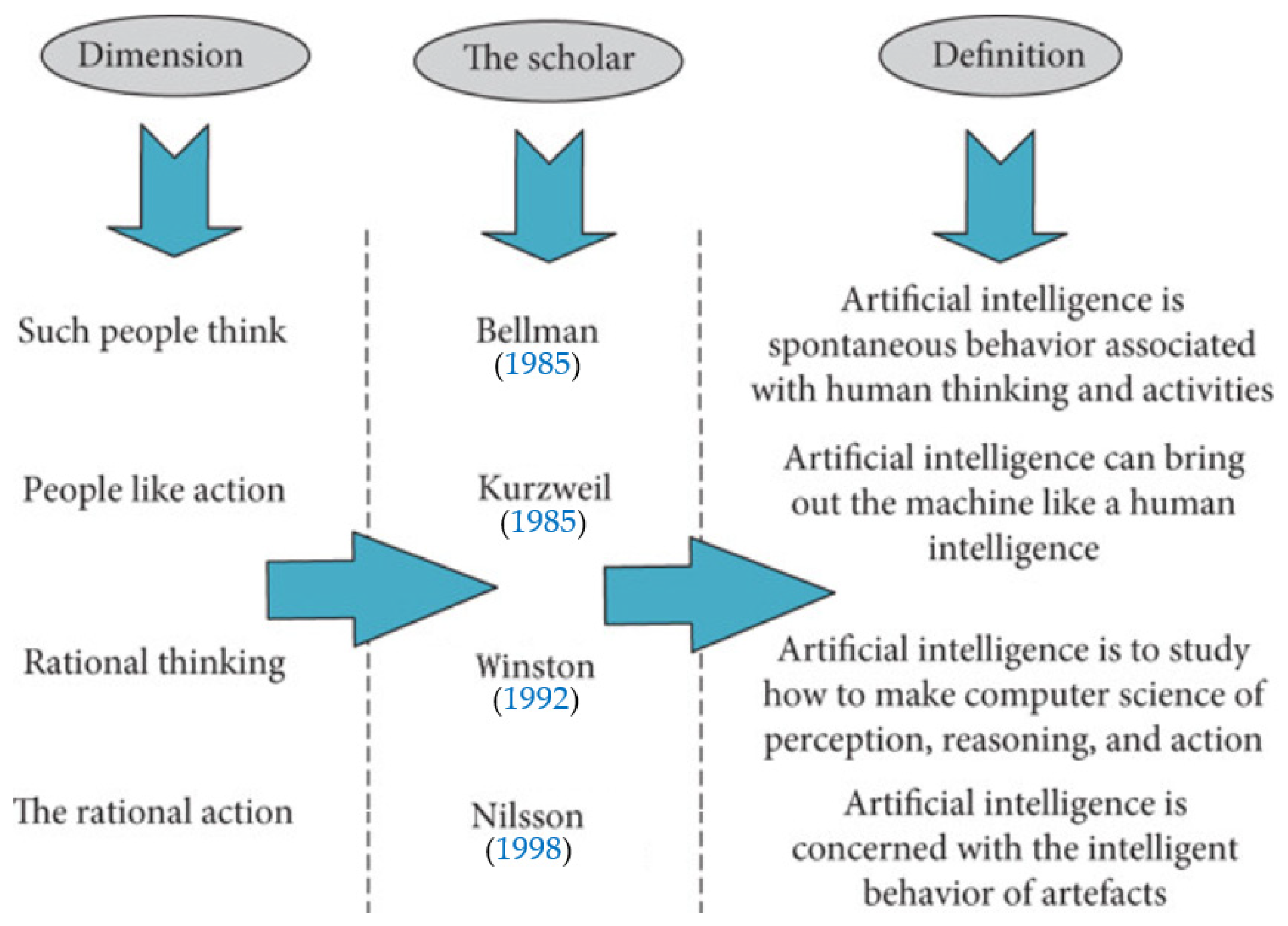
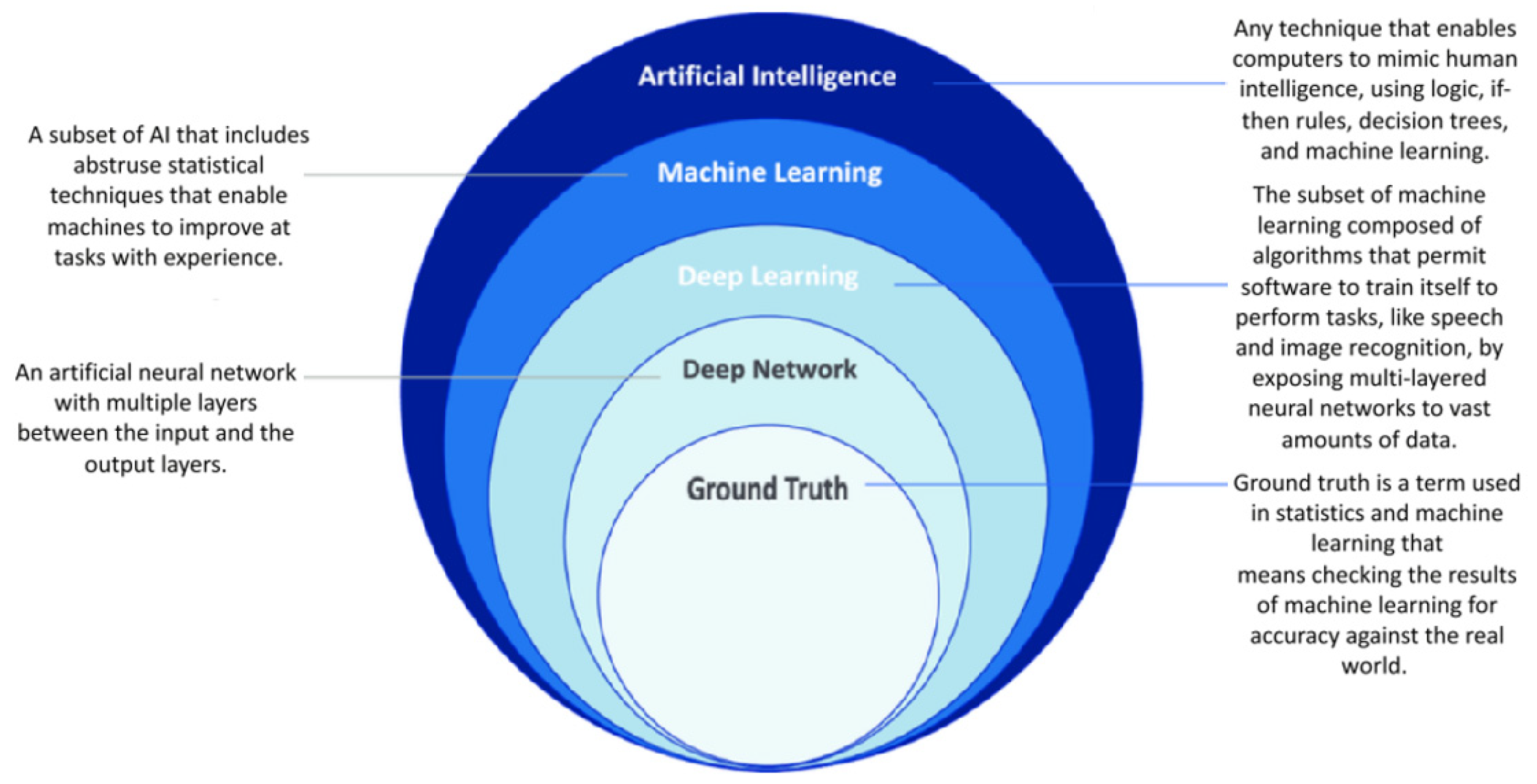
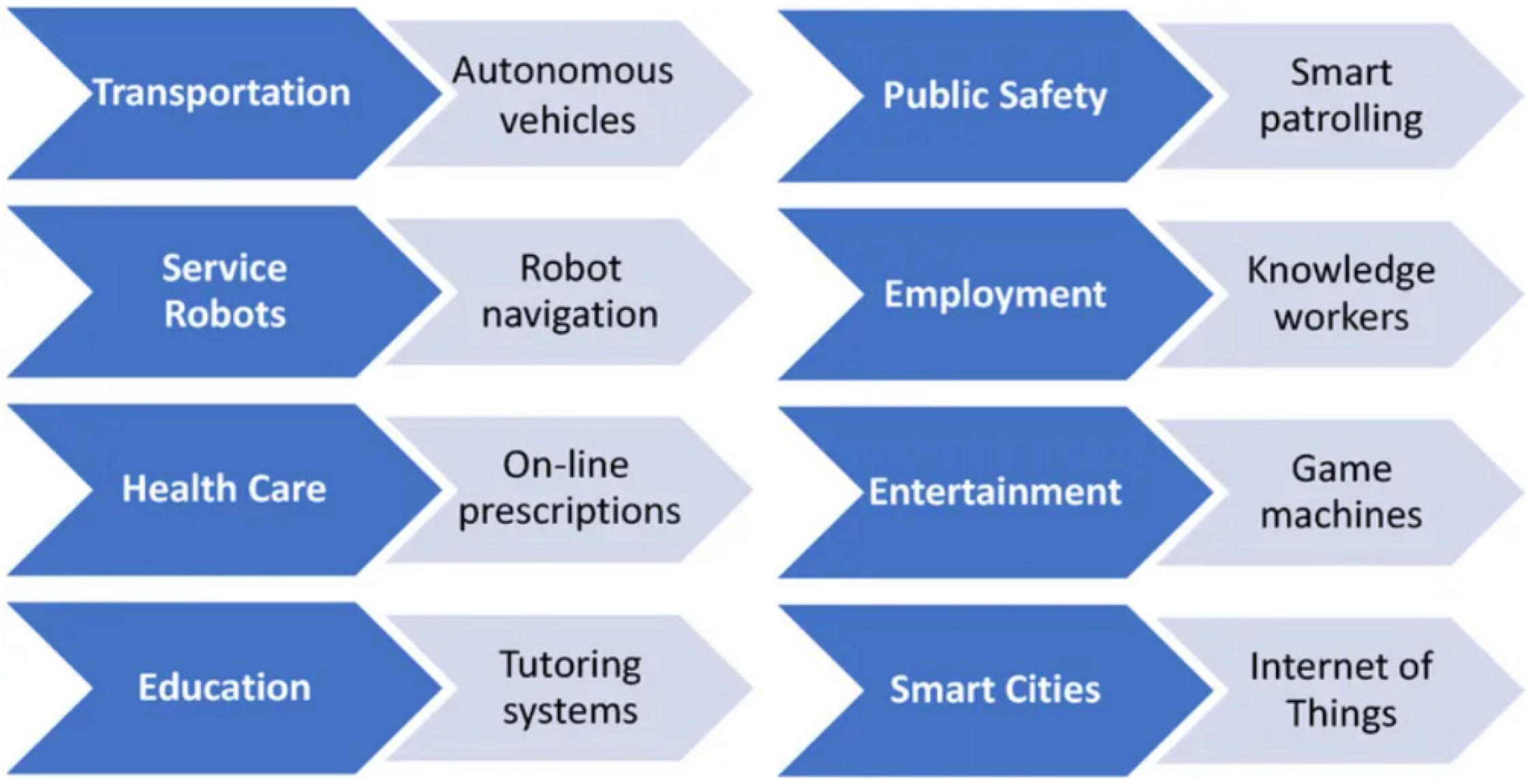
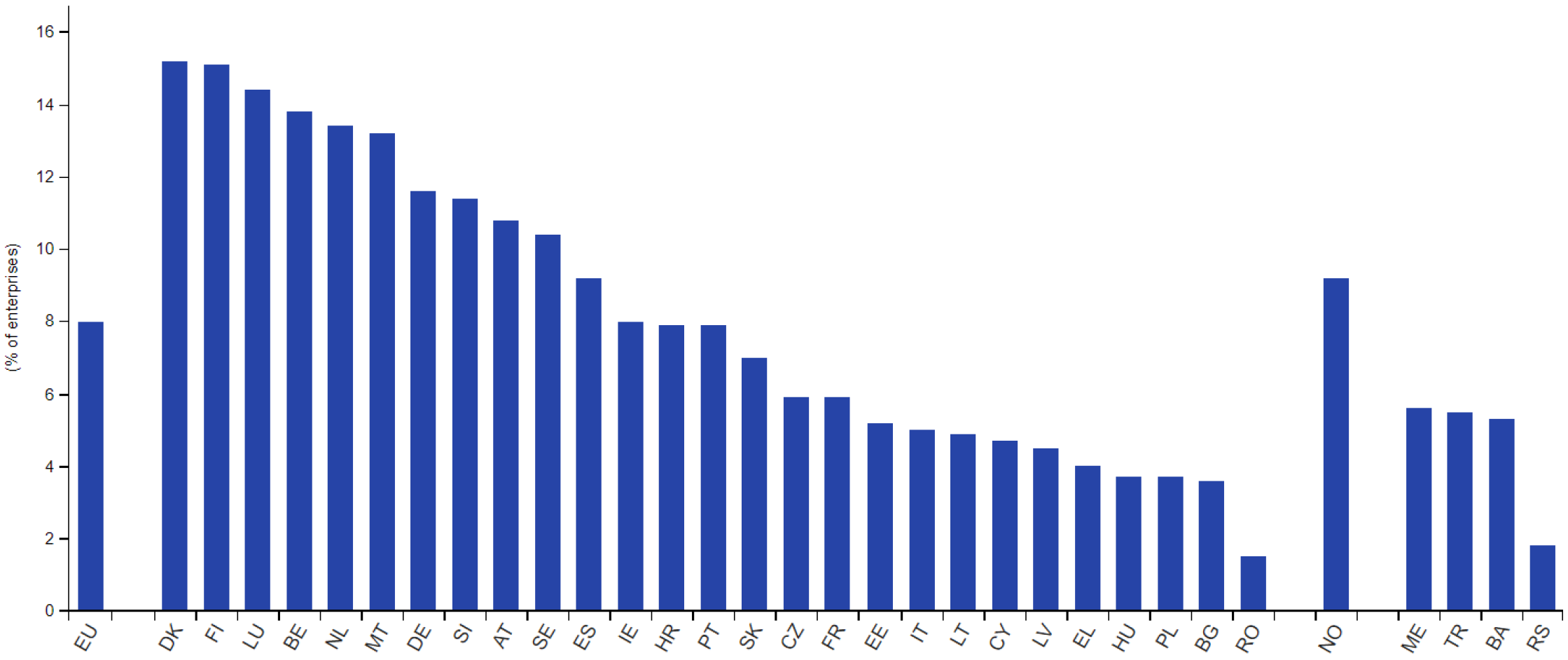
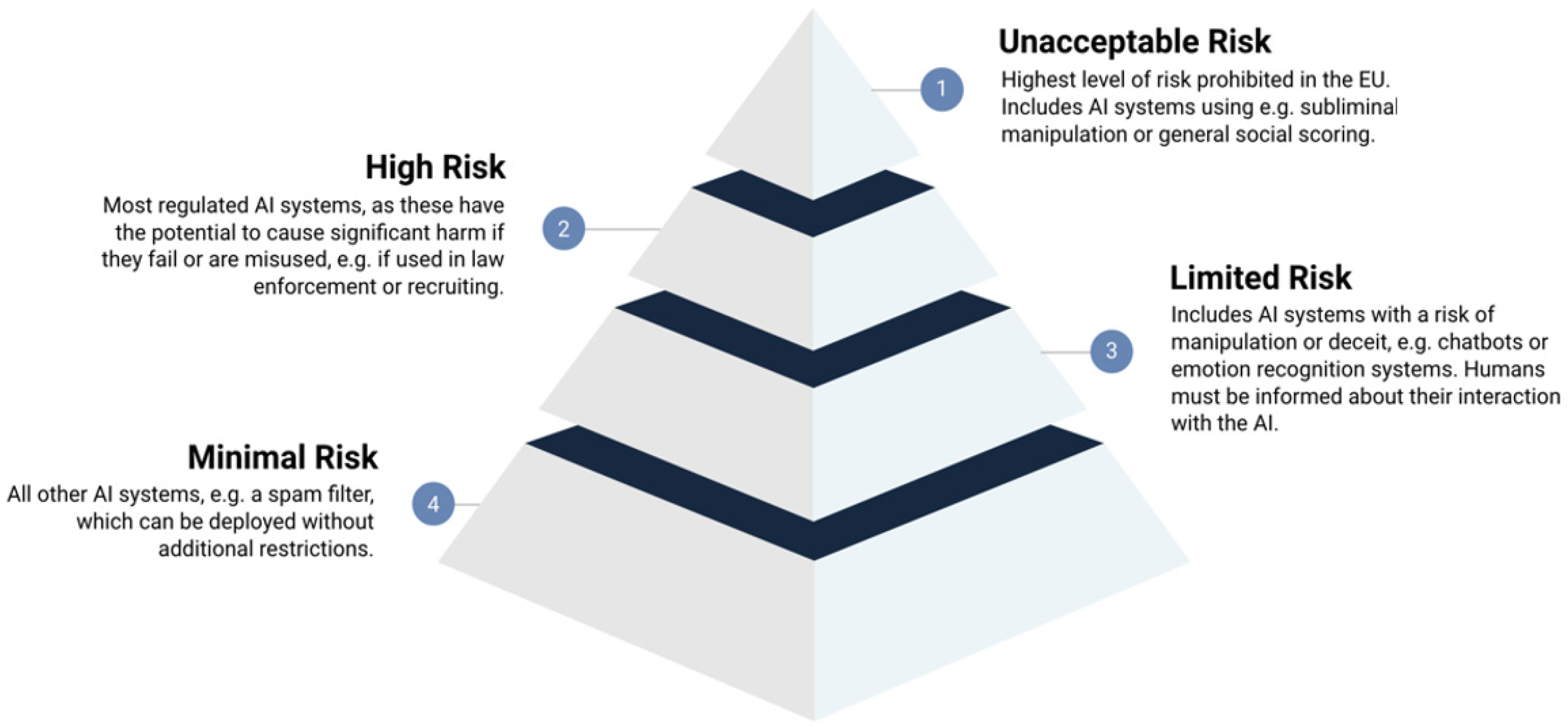
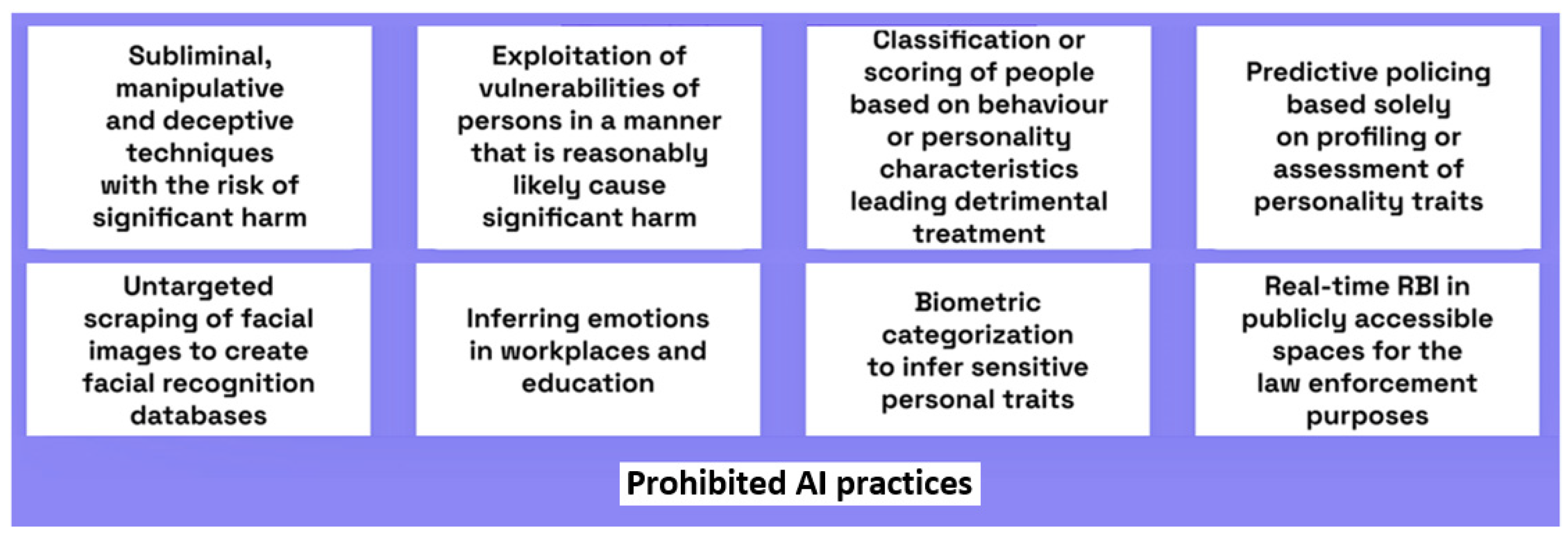
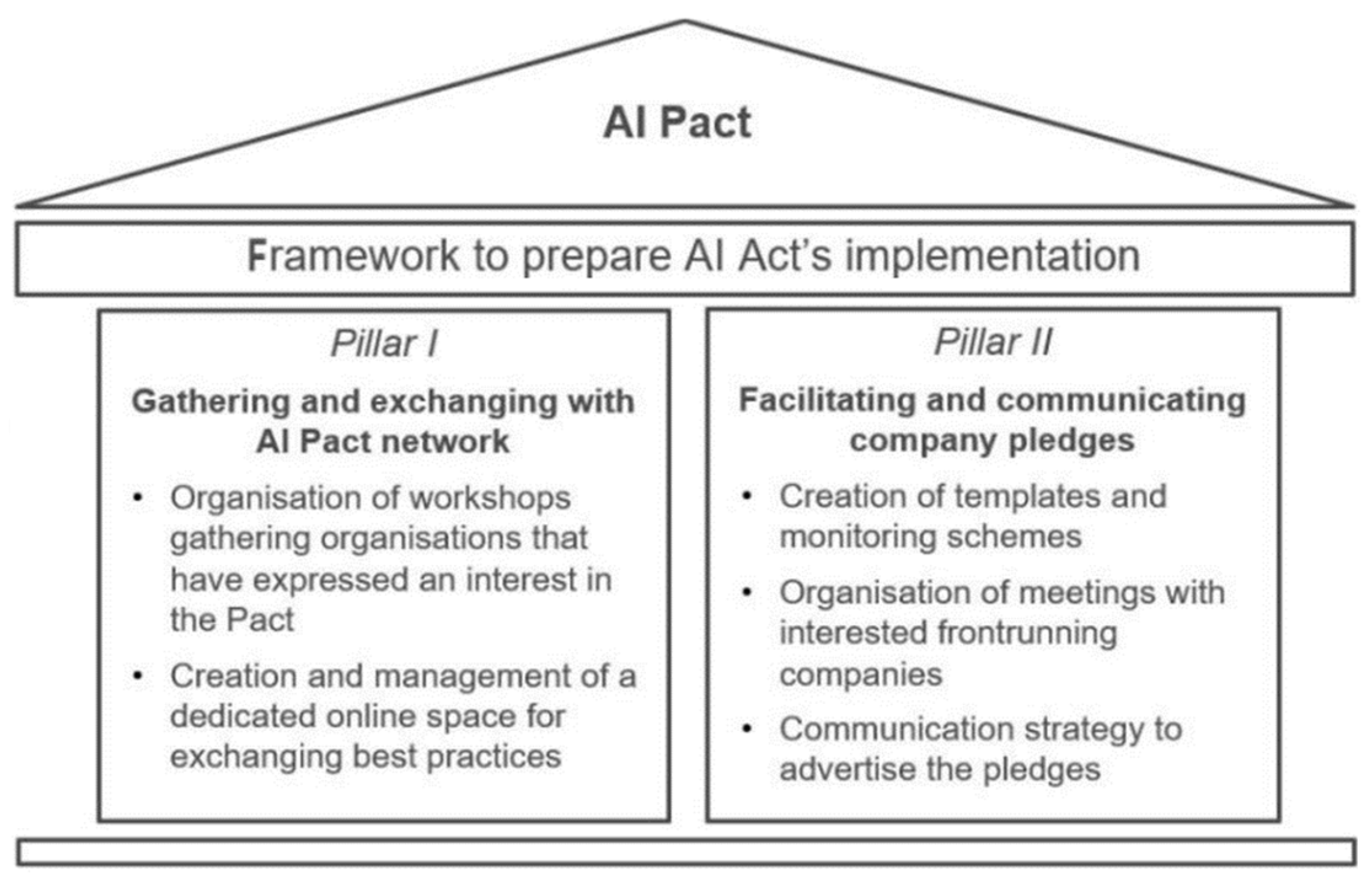
| Years | Significance/Achievements | Sources |
|---|---|---|
| 2018 | Press release: AI expert group and European AI alliance (March) | (EC, 2018a) |
| Declaration of cooperation on AI; Staff working document: Liability for emerging digital technologies; Communication: AI for Europe; Press release: AI for Europe (Achievements of April) | (EC, 2018b, 2018c, 2018f, 2018h) | |
| Set up of the high-level expert group on AI (AI HLEG); EC—Press release: AI made in Europe (Achievements of June) | (EC, 2018d, 2018k) | |
| Stakeholder consultation on draft ethics guidelines for trustworthy AI; EC—Communication: AI made in Europe; EC—Press release: AI made in Europe; EC: Coordinated plan on AI (Achievements of December) | (EC, 2018g, 2018i, 2018j) | |
| 2019 | AI HLEG: Ethics guidelines for trustworthy AI; EC—Communication: Building trust in human-centric AI (Achievements of April) | (EC, 2019a, 2019b) |
| AI HLEG: Policy and investment recommendations of AI; First European AI Alliance Assembly (Achievements of June) | (EC, 2019d, 2019e) | |
| AI HLEG: Piloting of assessment list of trustworthy AI (Achievements of December) | (EC, 2019c) | |
| 2020 | EC: white paper on AI: a European approach to excellence and trust; Public consultation on a European approach to excellence and trust in AI (Achievements of February) | (EC, 2020d, 2020f) |
| Inception impact assessment: Ethical and legal requirements on AI; AI HLEG: Final assessment list on trustworthy AI (ALTAI); AI HLEG: Sectorial recommendations of trustworthy AI (Achievements of July) | (EC, 2020a, 2020b, 2020c) | |
| 2nd European AI Alliance Assembly (Achievements of October) | (EC, 2020e) | |
| 2021 | EC: Communication on Fostering a European approach to AI; EC: Proposal for a regulation laying down harmonised rules on AI; EC: Updated coordinated plan on AI; EC: Impact assessment of an AI regulation (Achievements of April) | (EC, 2021a, 2021b, 2021d, 2021h) |
| Public consultation on Civil liability—adapting liability rules to the digital age and AI; EC: Proposal for a Regulation on Product Safety (Achievements of June) | (EC, 2021g, 2021j) | |
| Council of the EU: SI Presidency compromise text on the AI Act; High-Level Conference on AI: From Ambition to Action (3d European AI Alliance Assembly); European Economic and Social Committee, Opinion on the AI Act (Achievements of November) | (EC, 2021c, 2021i, 2021k) | |
| Committee of the Regions, Opinion on the AI Act; European Central Bank, Opinion on the AI Act (Achievements of December) | (EC, 2021e, 2021f) | |
| 2022 | Launch of first AI regulatory sandbox in Spain: Bringing the AI Regulation forward (Achievements of June) | (EC, 2022b) |
| Proposal for an AI liability directive (Achievements of September) | (EC, 2022c) | |
| General approach of the Council on AI Act (Achievements of December) | (EC, 2022a) | |
| 2023 | EP’s negotiating position on AI Act (Achievements of June) | (EC, 2023b) |
| Political agreement on the AI Act reached by the co-legislators (Achievements of December) | (EC, 2023a) | |
| 2024 | AI innovation package to support AI startups and SMEs (Achievements of January) | |
| European AI Office (Achievements of February) | (EC, 2024a, 2024d, 2024e) | |
| AI Act enters into force (1 August) |
| General Objectives | Specific Objectives |
|---|---|
| GO1. Supporting education for RDI and the development of AI-specific skills | SO1.1. Increasing the training capacity and skill level of AI specialists |
| SO1.2. Raising the general population’s basic understanding of the benefits, use, and regulation of AI technologies | |
| GO2. Efficient development and use of infrastructure and datasets | SO2.1. Developing AI-specific hardware and software infrastructure, and ensuring transparent and equitable access to it to facilitate RDI and production processes in this field |
| SO2.2. Expanding the use of datasets with applications across various sectors | |
| GO3. Developing the national Research–Development–Innovation system in the field of AI | SO3.1. Developing fundamental and applied scientific research specific to AI, as well as interdisciplinary research |
| SO3.2. Reducing the fragmentation of RDI resources and efforts in AI by coordinating and synchronizing them within national centers and specialized innovation groups, connected to international AI centers and resources | |
| SO3.3. Supporting and promoting innovation in the field of AI | |
| GO4. Ensuring technology transfer through partnerships | SO4.1. Improving the valorization of research results by developing technology transfer capacities |
| SO4.2. Establishing and organizing a national network of Testing and Experimentation Facilities (TEFs) for AI solutions | |
| GO5. Facilitating AI adoption across society | SO5.1. Adopting AI technology in the public sector |
| SO5.2. Adopting and leveraging AI technologies across various sectors | |
| GO6. Developing a governance and regulatory system for AI | SO6.1. Ensuring a governance framework for AI development |
| SO6.2. Facilitating AI development through regulation and standardization |
Disclaimer/Publisher’s Note: The statements, opinions and data contained in all publications are solely those of the individual author(s) and contributor(s) and not of MDPI and/or the editor(s). MDPI and/or the editor(s) disclaim responsibility for any injury to people or property resulting from any ideas, methods, instructions or products referred to in the content. |
© 2025 by the author. Licensee MDPI, Basel, Switzerland. This article is an open access article distributed under the terms and conditions of the Creative Commons Attribution (CC BY) license (https://creativecommons.org/licenses/by/4.0/).
Share and Cite
Bostan, I. Consolidating the Role of AI in the Economy and Society: Combating the Deepfake Phenomenon Through Strategic and Normative Approaches—The Case of Romania in the EU Context. Economies 2025, 13, 129. https://doi.org/10.3390/economies13050129
Bostan I. Consolidating the Role of AI in the Economy and Society: Combating the Deepfake Phenomenon Through Strategic and Normative Approaches—The Case of Romania in the EU Context. Economies. 2025; 13(5):129. https://doi.org/10.3390/economies13050129
Chicago/Turabian StyleBostan, Ionel. 2025. "Consolidating the Role of AI in the Economy and Society: Combating the Deepfake Phenomenon Through Strategic and Normative Approaches—The Case of Romania in the EU Context" Economies 13, no. 5: 129. https://doi.org/10.3390/economies13050129
APA StyleBostan, I. (2025). Consolidating the Role of AI in the Economy and Society: Combating the Deepfake Phenomenon Through Strategic and Normative Approaches—The Case of Romania in the EU Context. Economies, 13(5), 129. https://doi.org/10.3390/economies13050129







